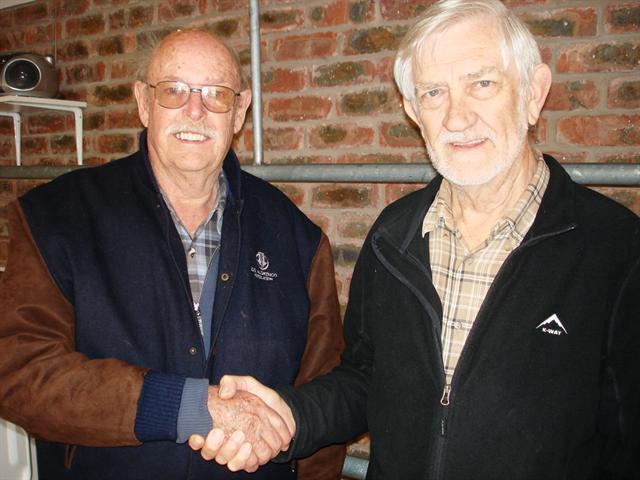This follows Outgoing Chairperson Jack van der Lecq's announcement that his architectural business is demanding too much of his time and resources, which have compelled him to resign as Chairperson and for his capable deputy, René de Kock to step in.
De Kock accepted the position at the society's recent Annual General Meeting.
The meeting glided through the last report of the departing Society Chairperson, the election and installation of new Chairperson De Kock, the return of most of the serving Executive Committee and the delivery of two interesting guest speaker papers.
Van der Lecq reflected back on the progress made in Heritage's re-organisation to bring it in line with the revised legislative requirements of the Heritage Resources Act, including its registration as a Public Benefit Organisation (PBO) and Non-Profit Organisation (NPO).
He also highlighted progress achieved at technical level by the weekly Aesthetics Committee, in liaising with the Municipal Planning Department over Heritage-sensitive plans and submissions. This and other interfaces with the Municipal authorities mark an overall improvement in liaison and co-operation between Heritage and local government.
However, he expressed his concern about the lack of human and financial resources, as older members became less active and recruitment of fresher resources lagged. He said the incoming committee need to urgently address these issues to ensure the success of the ongoing initiatives on which he had reported.
Successful outings in and around iconic Heritage sites continue to be arranged and be well-supported by Society members and the public.
De Kock thanked Van der Lecq for his professional leadership of the Society and his willingness to remain available as a special consultant on the executive committee.
De Kock also acknowledged the support given by Mbulelo Mrubatha, Manager of the Dias Provincial Museum, who had made the facilities of the museum available to Heritage for the AGM and always extended a hand of co-operation on matters of mutual importance. He pledged the Society's reciprocal support for the Dias Museum's programmes and campaigns.
In another brief presentation, the audience were given insight into the exciting development projects in town, with regard to the upgrading of key business, tourism and residential areas - all of which promise job creation and economic growth.
This include the recently revealed Transnet initiatives for the harbour and railway precincts redevelopments, the Point precinct studies and the scientific and academic development potentials surrounding the unfolding archaeological cave discoveries along the coast, which may see the establishment of a world-class Interpretation Centre being established in Mossel Bay.
In a light anecdotal peek behind-the-scenes, raconteur Jan Nieuwoudt of Great Brak River shared amusing tales of the special efforts that had to be made to get the replica Caravel to Mossel Bay on time for the great half millenium Dias Festival of 1988, and how disaster was narrowly averted while inducing modern technologies to boost the sailboat's progress.
Retired Doyen Architect Pieter Joubert also gave a clinical analysis of 'The Importance of the Development of Precincts'. A resident of Mossel Bay and member of Heritage Mossel Bay's executive committee, Joubert took the audience on a slide show tour of some of the world's great cities and towns' differing precinct and district characters, before returninh the focus to Mossel Bay.
He stressed the responsibility of town planners and developers to ensure that the existing character, look and feel of developed and especially heritage-rich built areas, are not compromised by the mixing in of uncharacteristic architectural styles, which could destroy the harmony of the established neighbourhoods.
He rounded up with warm praise for the Mossel Bay Municipality for the manner in which in recent years, it had followed best world architectural practice when developing the Dias Beach precinct, by creating a separate identifiable zone where the modern layout and designs work in harmony and do not interfere with the established old stone buildings.
He holds Mossel Bay as an exemplary model for other cities and towns of similar age and character, for how the demands of modern styling, design and application can be planned to fit without clashing.
The AGM ended with the serving of home-made soup and bread, measing up to to the best of traditions and was eagerly devoured amid the warm buzz of discussion and exchanges over the meeting's content.
Outgoing Heritage Mossel Bay Chairperson Jack van der Lecq (right) congratulates his newly elected successor, René de Kock of Great Brak River, at the recent AGM, which took place in the Granary Training Centre at the Dias museum.Pieter Joubert, retired former President-in-Chief of the South African Institute of Architects and lecturer and examiner in architecture for over 28 years at the University of the Orange Free State, addresses the Heritage Mossel Bay AGM on the importance of the planned development of precincts in the balanced strategic structures of townscapes. Joubert held the audience in rapt attention as he showed how the principles to which he referred, applied with good effect right here in Mossel Bay.

Outgoing Heritage Mossel Bay Chairperson Jack van der Lecq (right) congratulates his newly elected successor, René de Kock of Great Brak River, at the recent AGM, which took place in the Granary Training Centre at the Dias museum.















